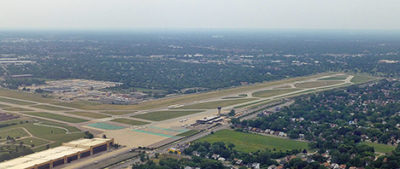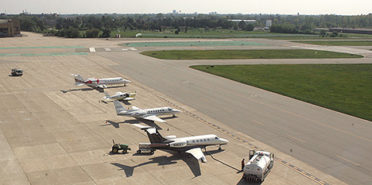
Nov. 6, 2017
What began as a simple maintenance request has blossomed into an all-out effort to educate the community and local leaders about the importance of Detroit’s Coleman A. Young International Airport (DET), as city leaders explore options to repurpose the airfield for non-aviation use – a threat that targets a number of general aviation airports across the country.
Formed earlier this year, the Coleman A. Young International Airport Education Association is a broad coalition of airport-based businesses and other concerned stakeholders. Executive Director Dave Tarrant said the organization’s roots stem in part from his flying club’s attempts to have a hangar door repaired two years ago.
“We first approached the airport manager, and eventually attracted the city administration’s attention,” he explained. “We learned about the field’s deeply rooted problems and the frustration among others dependent on the airport.”
Joining with the flying club were fixed-based operator AvFlight and business aviation flight department Air Eagle, as well as organizations including the Black Pilots of America, Civil Air Patrol, Tuskegee Airmen and Museum and the longstanding Friends of Detroit City Airport group.
Once a busy airport, traffic figures slipped in the aftermath of Detroit’s budgetary woes and the 2009 recession. The field, located about 6 miles northeast of downtown Detroit, remains the eighth busiest towered airport in Michigan, however, with more than 42,000 operations in 2016.
Despite those figures, earlier this year the city contracted a study of alternative uses for the valuable property, including possible closure of DET. “There was a lack of understanding about the airport’s value, and that’s not a situation unique to DET,” said Air Eagle General Manager and Chief Pilot Michael Zabkiewicz. “Every airport is at risk, and we hope ours will ultimately be given the resources necessary to undergo a complete revitalization.”

One of the education association’s first attempts to change perceptions was at a city council meeting this summer, where group members spoke of the airport’s economic importance and its role in securing airspace near the Canadian border. DET is 10 miles from the border, and its tower provides low-altitude radar coverage.
Association member Keith Newell noted the council wasn’t aware that DET could potentially receive millions in improvements over the next ten years – of which the city would only need to front a small portion of, if the city went through the request and approval process and received the appropriate approvals – and that it could also accept FAA funds to offset much of the cost to refurbish Runway 15/33. “Accepting federal funds would mean they’d only need to spend a fraction of the amount,” he said. “That’s a very small investment for a potentially very large return.”
In addition to their regular presence at council meetings, association members are active in community outreach efforts, including an airport clean-up event in August. The group is also working to help return the Benjamin O. Davis Aerospace Technical High School to the airport grounds, after the school moved off the airport in 2013.
NBAA Central Region Representative Bob Quinn applauded the association’s efforts, emphasizing that NBAA stands ready to assist in securing the airport’s future and ensure the city is aware of its ongoing obligations to maintain DET as an airport in perpetuity under terms of its prior acceptance of federal funds.
“This group has taken on a huge challenge, and has done an amazing job with coordinating their efforts in just a matter of months,” said Quinn. “DET is one of the city’s greatest assets, and it’s an incredibly vital tool as Detroit seeks to attract high-tech businesses that need quick access.”


 International Business Aviation Council Ltd.
International Business Aviation Council Ltd.